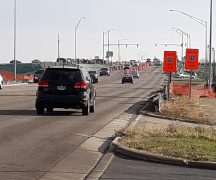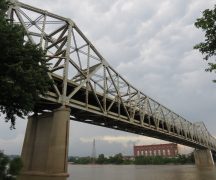By Laura Olson
WASHINGTON — Pennsylvania’s 7,540 miles of highway roads in poor condition. Florida’s $100 billion in damages over the last decade from extreme weather events. The 1 in 4 Idahoans with no access to broadband internet, and 1 in 2 living in areas with too-few licensed child care centers.
In the next phase of President Joe Biden’s sales pitch for his $2 trillion infrastructure package, his administration is framing its argument around the mounting, unmet needs in states as it seeks to build public support for another massive spending bill. Democrats are also hitting back at criticisms from congressional Republicans that the mammoth package goes too far beyond the road-and-bridge projects typically associated with infrastructure.
The White House released a set of state-by-state breakdowns on Monday detailing the number of bridges in severe disrepair, increased commuting times due to lack of investment in transit, and growing costs related to ensuring that drinking water systems are safe and clean, as well as funding in the proposal intended to tackle those problems. (The assessment for Ohio states: “For decades, infrastructure in Ohio has suffered from a systemic lack of investment.”)
Democrats in addition contend that child care and care for older adults and those with disabilities are critical for supporting the country’s economy and overall well-being, along with access to high-speed internet.
“What they really do is identify the needs in these states and how this package could benefit” states, White House Press Secretary Jen Psaki said Monday, adding: “There are different types of funding for infrastructure that would be worked through with Congress as the discussions proceed.”
The new fact sheets don’t offer any estimates on how much money any state could expect to receive if the proposed infrastructure package makes it through the narrowly divided Congress to the president’s desk.
Speaking to regional reporters Monday, Transportation Secretary Pete Buttigieg said it will be up to Congress to determine how exactly each of the many pots of money will be allocated.
Some dollars likely would be doled out through existing grant programs or using formulas based on a state’s population or other factors.
Congress also is expected to allocate money directly for specific projects, reviving a process known as earmarking that could be used to entice skeptical legislators to support a bill by sending money to their home districts and states.
Though specifics of how various dollars will be distributed are yet to be determined, Buttigieg said the overall approach will be intended to be “user-friendly” for state and local officials to figure out.
“The goal is to be responsive when questions come in, and to try to make the process as simple as can be, so you don’t have to be a large enough community to have full-time federal relations experts in order to navigate any application process,” Buttigieg said.
But in order to have any funding to apply for, the Biden administration will need to combat criticism from Republicans at the proposal’s price tag and its unusually broad definition of critical infrastructure.
Senate Majority Leader Mitch McConnell, (R-Ky.), on Monday called the infrastructure package “a motley assortment of the left’s priciest priorities,” and a bait-and-switch from what voters expect from an infrastructure package.
“Less than 6% of this proposal goes to roads and bridges,” he said. “It’s not remotely targeted toward what Americans think they’re getting when politicians campaign on infrastructure.”
Responding to such critiques, Buttigieg pointed to massive national projects like the transcontinental railroad or the interstate highway system, arguing that those ambitious programs also changed how Americans thought about infrastructure.
“They challenged the country to expand its definition of infrastructure from what had prevailed in the past,” Buttigieg said, arguing that broadband internet is just as critical today as those projects were.
Asked how he’s pitching the proposal to Republican lawmakers and governors, Buttigieg replied that he hasn’t needed to argue why there’s a need for more investments, emphasizing that the size of the package will ensure that every state benefits.
The Biden administration’s state-centered fact sheets were published hours ahead of a bipartisan White House meeting between Biden and a handful of lawmakers, including Republican Rep. Garret Graves of Louisiana and Democratic Rep. David Price of North Carolina.
Graves serves on the Transportation & Infrastructure Committee, and Price is chairman of the Appropriations Committee’s panel on transportation spending.
According to the White House’s fact sheet on North Carolina, the state has 1,460 bridges and more than 3,116 miles of highway in poor condition, linking the condition of those roads and bridges to commute times that have risen 10% and higher annual costs to drivers.
In Louisiana, some 30 extreme weather events between 2010 and 2020 cost the state up to $50 billion in damages, according to the White House. That’s the same amount as the overall total that the Biden administration has proposed for making the country’s infrastructure more resilient to threats from natural disasters.
***
Also from Ohio Capital Journal:
If sports gambling is legalized, where should Ohioans be able to place their bets?
Momentum appears to be growing for legalized sports betting in Ohio.
The key question of where Ohioans will be able to place bets is being debated, and the decision could have major implications for businesses and schools.
One by one, states across the country are embracing this fast-growing industry as a way of capturing tax revenue for public services. If legalized here, Ohioans might be able to place bets inside bars, restaurants and bowling alleys. There could be sports books inserted within the state’s casinos and racinos.
Besides retail betting, gaming advocates envision legal bets placed in Ohio with the touch of a phone.
Ohio lawmakers are expected to soon introduce a proposal to legalize and regulate sports betting in the state. A group of legislators have spent the early months of 2021 hearing ideas from industry leaders about how such a system could work here. READ MORE
Law takes effect legalizing concealed knife carry; also allows for brass knuckles
Ohioans can now secretly carry knives under a new law that took effect Monday.
Prior law prohibited anyone in the state from carrying a concealed “deadly weapon” other than a handgun. House Bill 140 codifies into the law that knives, razors, or cutting instruments not used as a weapon do not count as a “deadly weapon.”
Similarly, the new law allows for the manufacturing, sale and possession of brass knuckles, cestuses, billy clubs, blackjacks, sandbags, switchblade knives, springblade knives, gravity knives, and similar weapons.
The bill passed on a nearly unanimous vote in the Senate (one Democrat opposed) and roughly on party lines in the House where five Democrats joined all Republicans voting in favor.
“This is a great day for Ohioans who no longer have to worry that they might be arrested under a dangerously vague state law for carrying a common tool, their pocket-knife, concealed in their pocket,” said Doug Ritter, an advocate and founder of Knife Rights, an advocacy group. READ MORE





